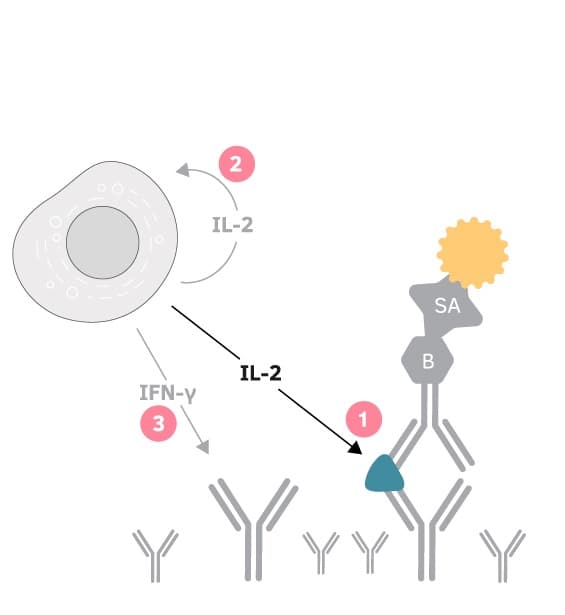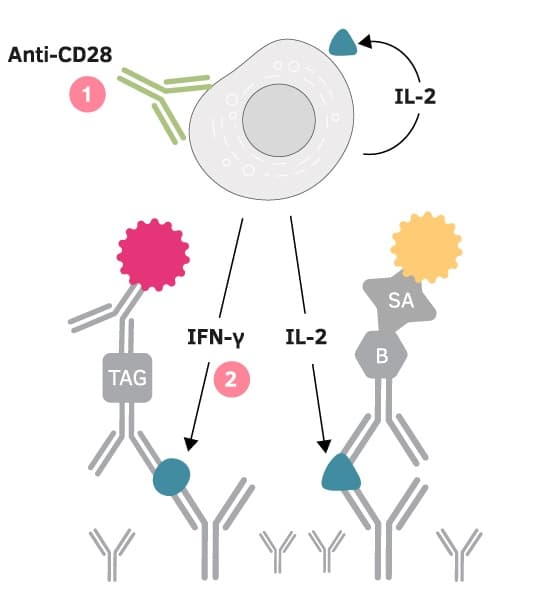Anti-human IgA mAb (MT57), unconjugated
Anti-human IgA mAb (MT57), unconjugated
$210
In stock
Delivery 4-9 business days
Shipping $0
Complementary products
Complementary products
Documents
Non-human primate cross-reactivity guide
The systems reactive with NHPs are either based on cross-reactive human kits or specifically developed monkey kits (NHP).
Cross-reactivity verification tests have been performed in ELISpot and/or ELISA by Mabtech and/or by others. Evaluations of assays with less solid evidence of cross-reactivity are shown as symbols within parentheses.
| ApoA1 | |||||||||
| ApoB | |||||||||
| ApoE (NHP) | |||||||||
| ApoE | |||||||||
| ApoH | |||||||||
| CCL2 (MCP-1) | |||||||||
| CCL4 (MIP-1β) | ( ) | ( ) | ( ) | ( ) | ( ) | ||||
| CCL22 (MDC) | ( ) | ( ) | ( ) | ( ) | ( ) | ||||
| CD25 | |||||||||
| GM-CSF | ( ) | ( ) | |||||||
| Granzyme A | |||||||||
| Granzyme B (NHP) | |||||||||
| Granzyme B | |||||||||
| IFN-α2 | |||||||||
| IFN-α pan | ( ) | ||||||||
| IFN-γ (NHP) | |||||||||
| IFN-γ | ( ) | ||||||||
| IgA (NHP) | |||||||||
| IgA | |||||||||
| IgG | |||||||||
| IgM | |||||||||
| INS | |||||||||
| IL-1α | |||||||||
| IL-1β | |||||||||
| IL-2 (NHP) | |||||||||
| IL-3 | |||||||||
| IL-4 | ( ) | ( ) | ( ) | ( ) | |||||
| IL-5 | ( ) | ( ) | ( ) | ||||||
| IL-6 | ( ) | ( ) | ( ) | ||||||
| IL-8 (NHP) | |||||||||
| IL-8 (ELISA) | |||||||||
| IL-8 (ELISpot) | |||||||||
| IL-10 (NHP) | |||||||||
| IL-10 | |||||||||
| IL-12/-23 (p40) | |||||||||
| IL-12 (p70) | |||||||||
| IL-13 (NHP) | ( ) | ( ) | ( ) | ||||||
| IL-13 | |||||||||
| IL-17A (NHP) | ( ) | ( ) | |||||||
| IL-17A | |||||||||
| IL-17F | |||||||||
| IL-17A/F | |||||||||
| IL-21 | |||||||||
| IL-22 | |||||||||
| IL-23 | |||||||||
| IL-27 | |||||||||
| IL-31 | |||||||||
| IP-10 | |||||||||
| Perforin | ( ) | ||||||||
| TGF-β1 (latent) | |||||||||
| TNF-α (NHP) | ( ) | ( ) | ( ) | ( ) | ( ) | ||||
| TNF-α | |||||||||
| CD3, mAb CD3-1 | |||||||||
| CD3, mAb CD3-2 | |||||||||
| CD28, mAb CD28-A | |||||||||
| IFN-γ mAb 1-D1K | ( ) | ( ) | ( ) | ( ) | ( ) | ( ) | |||
| IL-2 mAb MT8G10 | ( ) | ( ) | ( ) | ( ) | ( ) | ( ) | ( ) | ||
| IL-4 mAb IL4-3 | ( ) | ||||||||
| IL-17A mAb MT504 | |||||||||
| Perforin mAb Pf-344 | |||||||||
| TNF-α mAb MT15B15 | |||||||||
| IgG1 mAb MTG1218 | |||||||||
| IgG1 mAb MT1939 | |||||||||
| IgG2 mAb H6200 | |||||||||
| IgG2 mAb MTG211E | |||||||||
| IgG3 mAb MTG34 | |||||||||
| IgG4 mAb MTG42 | |||||||||
| IFN-γ mAb MT111W | ( ) | ( ) | ( ) | ( ) | ( ) | ( ) | ( ) | ( ) | ( ) |
| TNF-α mAb MT15B15 | ( ) | ( ) | ( ) | ( ) | ( ) | ( ) | ( ) |
Symbol keys:
Verified by Mabtech and/or by others. Tests performed in ELISpot and/or ELISA.
- good
- poor
- no
Based on reports from others or by analysis using recombinant proteins.
- ( ) good
- ( ) poor
- ( ) no
Specifically developed monkey kits are marked with (NHP).
Blank boxesRepresent cross-reactivities not evaluated.
* Comprises several species. Cross-reactivity may have to be verified on a species basis.
Analyte combinations in FluoroSpot
Find out which analyte combinations we have evaluated in T cell FluoroSpot and which combinations are affected by capture effects or not.
What is a capture effect?
When capture antibodies with different specificities are coated together, the capture of one cytokine may affect the secretion of other cytokines. This is usually more pronounced when studying T cell responses with polyclonal stimuli compared to antigen-specific responses. Capture effects are seldom a problem and can often be counteracted by the addition of an anti-CD28 antibody.
(1) IL-2 secreted by the activated T cell is captured by coated anti-IL-2 capture antibodies. (2) As a result, IL-2-stimulation of the T cell itself (autocrine stimulation) as well as nearby T cells (paracrine stimulation) is impaired, ultimately leading to (3) decreased IFN-γ secretion.
Co-stimulation with anti-CD28
Anti-CD28 mAb provides a co-stimulatory signal to antigen-specific responses by binding to CD28 on T cells. The addition of an anti-CD28 mAb to the cell culture enhances antigen-specific responses and can counteract capture effects. For example, the presence of IL-2 capture antibodies may result in reduced activation of T cells, as capturing of IL-2 decreases the amount of available IL-2 and thereby dampens the IL-2-mediated stimulation of T cells. The addition of anti-CD28 mAb restores IFN-γ responses (depicted in the below images). Further optimization may be necessary, depending on the cells and stimuli used. Too high concentrations of the anti-CD28 mAb may result in an elevation of non-specific cytokine secretion.
(1) An anti-CD28 antibody can be added to provide a co-stimulatory signal that can restore (2) e.g. IFN-γ responses.
How to investigate capture effects
Our FluoroSpot Plus kits are evaluated for capture effects, and in studies of T cell responses we recommend co-stimulation with anti-CD28. With FluoroSpot Flex, it is possible to combine and build your own kit. For guidance look at our analyte combination table (above). Capture effects can be investigated by quantifying spot numbers in wells coated with single capture antibodies and compared to wells coated with a mixture of the capture antibodies. The compensatory effect of the anti-CD28 mAb may be assessed by comparing cells cultured with and without the anti-CD28 mAb.
Product highlights
Publications (53)
Analyte information
IgA
| Analyte description | IgA (Immunoglobulin A) represents only 10-15% of the total Ig molecules in serum but is the predominating Ig isotype in secretions and in the gastrointestinal and urogenital tract. The IgA found in secretions (secretory IgA or sIgA) is commonly a dimer with two IgA molecules joined by the J chain. Secretory IgA is the most important Ig isotype in mucous surfaces, the area of entry for most pathogens. |
| Alternative names | Immunoglobulin A, IgA, A2M, IgA1 |
| Cell type | B cell |
| Gene ID | 3494, 3493 |
You may also like


